India, Europe and Africa 2016
Pushkar is a small town which curls around a small holy lake, and is a prominent Hindu pilgrimage place. Though 10 years ago it probably saw far fewer tourists than other areas of Rajasthan, nowadays it's authentic allure is wearing ever so slightly thin. Though the lake is pretty, it is lined with ghats and with them, some very pushy Pushkar priests. It was impossible to be near the lake without being constantly hassled for donations and so after the first day, we gave up. The main bazaar is full of hippies and the few we spoke with had been there for at least a few weeks, some months. Fortunately, it didn't take much effort to get away from it by waling up nearby hills to small temples perched high above town.
The Saraswati temple was a favourite of ours. At the bottom of the hill was a camel resting are where camel drivers let their stock relax in the sand, and where we first got to watch camels’ huge, malleable feet splaying out on the ground. The big surface area and flexibility stops them from sinking into soft sand in the desert. From here, the path wound its way up the hill along well worn steps. Groups of langurs hung out along the sides, once again providing us with endless entertainment. Most of the groups were adult females with their young ones. Spending time with these youngsters set aside any doubt about where the term cheeky monkey comes from. The bold ones would jump and prance around the place from rock to rock, then scurry back to their mums, repeatedly. Adults were lining up to take a drink from the taps, considerately turning them off after they'd finished using them and taking it in turn to look after each other's kids. At times one monkey would be trying to control 3-4 boisterous
emily.j.buswell
30 chapters
16 Apr 2020
Jaipur to Pushkar
Pushkar
Pushkar is a small town which curls around a small holy lake, and is a prominent Hindu pilgrimage place. Though 10 years ago it probably saw far fewer tourists than other areas of Rajasthan, nowadays it's authentic allure is wearing ever so slightly thin. Though the lake is pretty, it is lined with ghats and with them, some very pushy Pushkar priests. It was impossible to be near the lake without being constantly hassled for donations and so after the first day, we gave up. The main bazaar is full of hippies and the few we spoke with had been there for at least a few weeks, some months. Fortunately, it didn't take much effort to get away from it by waling up nearby hills to small temples perched high above town.
The Saraswati temple was a favourite of ours. At the bottom of the hill was a camel resting are where camel drivers let their stock relax in the sand, and where we first got to watch camels’ huge, malleable feet splaying out on the ground. The big surface area and flexibility stops them from sinking into soft sand in the desert. From here, the path wound its way up the hill along well worn steps. Groups of langurs hung out along the sides, once again providing us with endless entertainment. Most of the groups were adult females with their young ones. Spending time with these youngsters set aside any doubt about where the term cheeky monkey comes from. The bold ones would jump and prance around the place from rock to rock, then scurry back to their mums, repeatedly. Adults were lining up to take a drink from the taps, considerately turning them off after they'd finished using them and taking it in turn to look after each other's kids. At times one monkey would be trying to control 3-4 boisterous
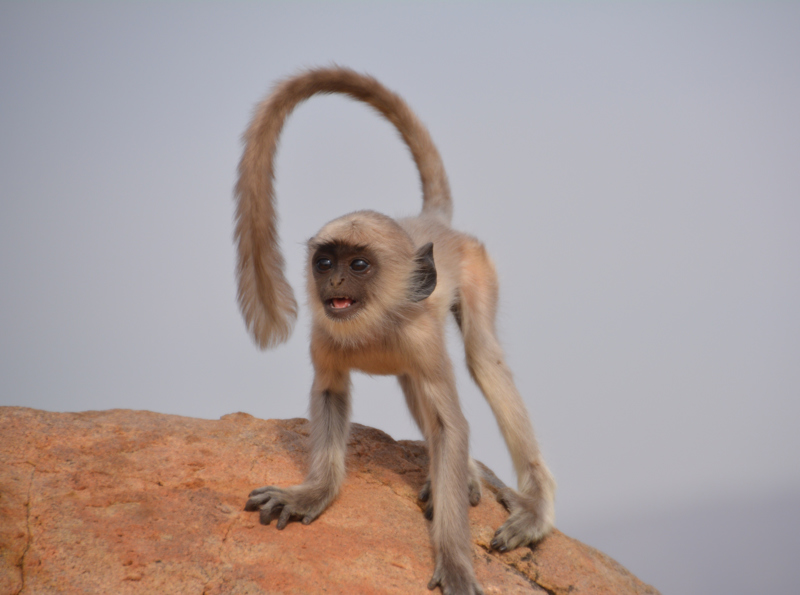
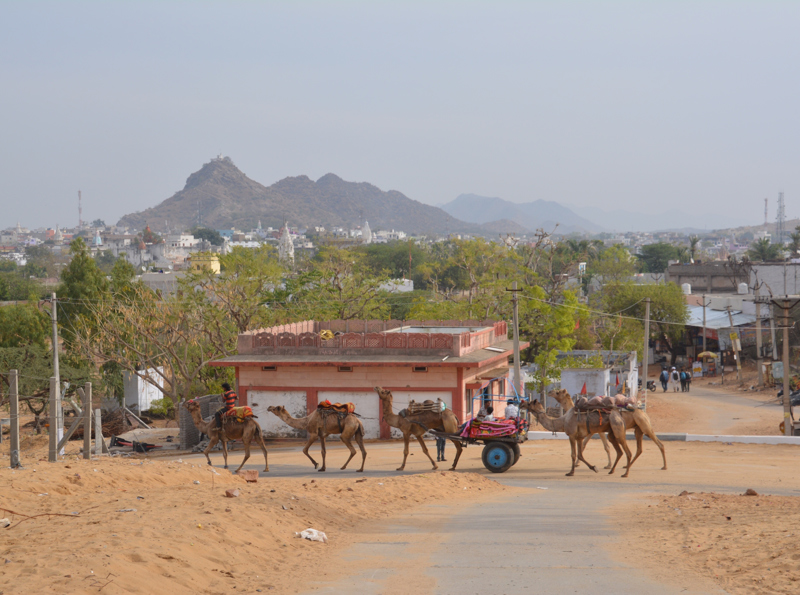
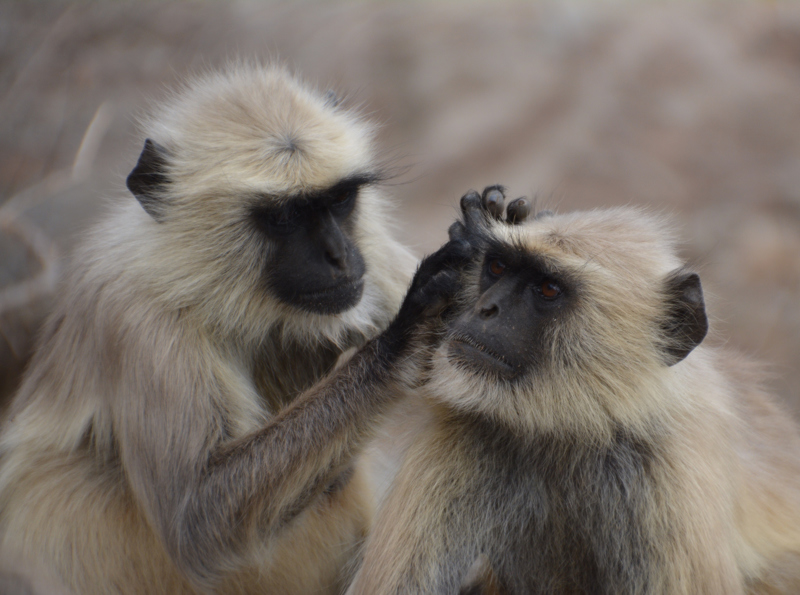
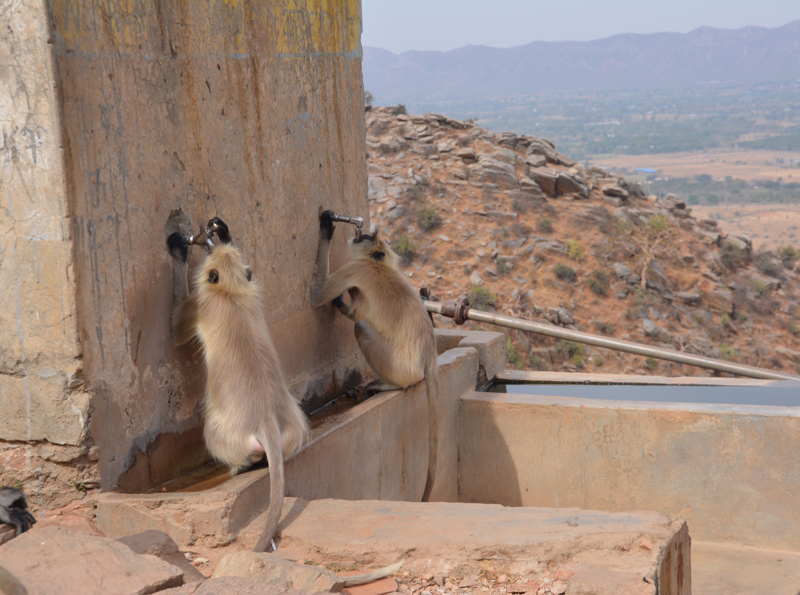
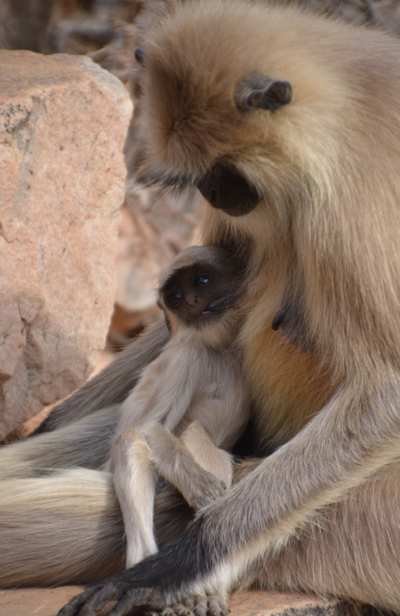
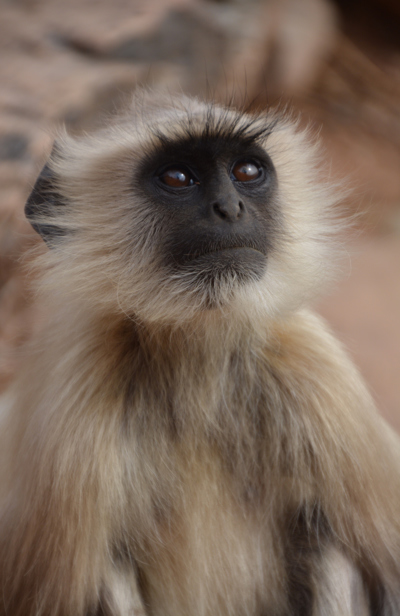
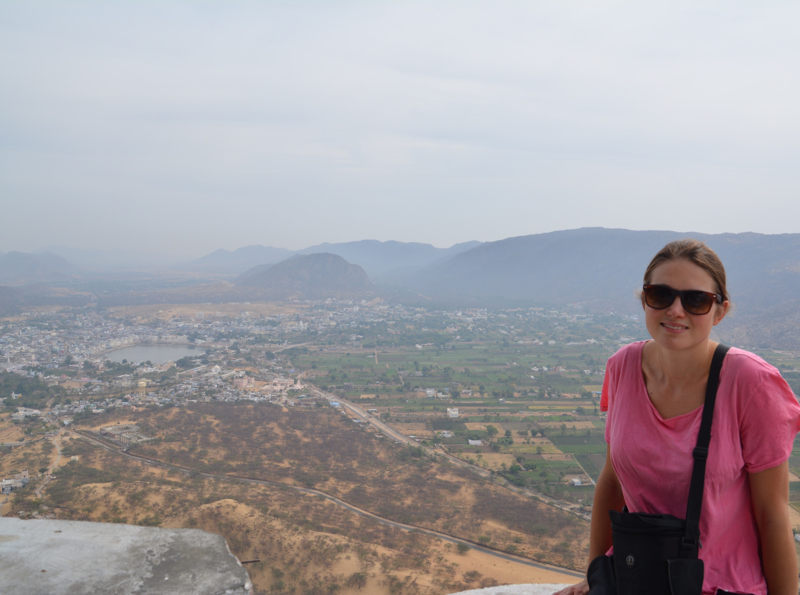

juveniles. After about an hour the adults decided we had become a bit too comfortable and overstayed our welcome, and one of them ran up with its teeth bared and grabbed me on the leg. In hindsight, she may have been after my camera and I should have let her have it, given what happened a few days later.
Thankful I had narrowly missed having to catch the quickest train to Delhi for rabies prophylaxis, we carried on to the top and enjoyed wonderful and very peaceful views of Pushkar. Fortunately, visiting temples nearest a chai stand is seen much more favourably by hindu gods than visiting those on hilltops, so we had the place pretty much to ourselves. On the way down Liam bought a bag of chips, but no sooner had he handed his money over and 2 monkeys were chasing him. Wide eyed, he threw them into my arms. It didn't take him long to realise this wasn't a good move. Firstly, because the bag was gone in a few seconds. Secondly, because he had to explain his reaction to me. His affection for monkeys dwindled while we watched them eating his chips in a nearby tree.
I decided to try to learn something about making the delicious food we’d been eating and took a mornings cooking lesson with a lovely woman from town. It was very interesting to spend a morning with someone who had such a lot of knowledge about food and cooking, as well as talking to me about some of the differences between women living in cities and in rural areas. She had first started running cooking classes and cooking for tour groups 20 years ago, when she met a Brazilian traveller in her textile shop. As far as she knew she was the only woman working in a shop in Pushkar at that time. Apart from my morning with her, our contact with women has been quite limited, and even as children the girls are far shyer and less likely to interact than the boys. I'm sure in larger cities, things are different but unsurprisingly, the literacy rates for males around about 20% higher than females.
One afternoon we hired a bike and went out to some villages around Pushkar where we saw the Indian version of herd homes. At this time of the year the ground is completely dry and nothing grows without irrigation so all the feed for the livestock, mostly Lucerne and wheat straw, is cut and carried to them. There seem to be a lot of cows around but apparently the vast majority of the milk produced is from buffaloes. It is preferred because it has a much higher fat percentage, and as I learnt in my cooking class, Indians aren't shy when it comes to fat. There are also lots of goats around, and we haven't seen goat on the menu anywhere we've been. Most of them are kept as milking goats and run in groups by one or two herders and occasionally a dog. Herders carry a long stick with a hook on the end of it so that they can reach up and shake trees to get leaves and shoots to fall to the ground. Desert life makes for slim pickings at this time of year but in a few months when the rainy season arrives, it will be transformed. We keep imagining how beautiful it must be.
Unfortunately just when we thought we were doing well on the delhi-belly front, Liam got sick and we decided to spend an extra day in Pushkar to recover. The only fortuitous part of it was that I got to climb to the top of the hill and watch the monkeys again, and have heavenly porridge for breakfast at the best breakfast café in India.
1.
Kolkata to Darjeeling
2.
Darjeeling
3.
Darjeeling to Kurseong
4.
Kurseong to Varanasi
5.
Varanasi to Khajuraho
6.
Khajuraho to Agra
7.
Agra to Jaipur
8.
Jaipur to Pushkar
9.
Pushkar to Bundi
10.
Bundi to Jodhpur
11.
Jodhpur to Jaisalmer
12.
Jaisalmer to Delhi
13.
Delhi to London
14.
London to Waterford
15.
Waterford to Tralee
16.
Tralee to Westport
17.
Westport to Mullingar
18.
Mullingar to Donegal
19.
Donegal to Belfast
20.
Belfast to Dublin
21.
Dublin to Berlin
22.
Berlin to Marburg
23.
Marburg to Munich
24.
Munich to Salzburg
25.
Salzburg to Ljubljana
26.
Ljubilana to Lake Bled and Postojna
27.
Postojna to Croatia part one
28.
Croatia to Bosnia-Hercegovina
29.
Bosnia to Croatia part 2
30.
Croatia to Italy